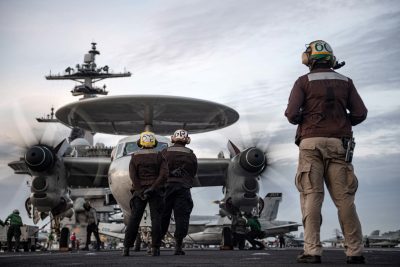The US–Philippines alliance is one of the most enduring arrangements in the Indo-Pacific, encompassing deep interpersonal ties and robust trade and investment partnerships. While the overarching relationship has been expanded, the military pact remains anchored in the Mutual Defense Treaty (MDT), a document that reflects the geopolitical dynamics of 1951 more than the realities of 2021. Pushing for a review of the MDT will improve the outlook of the US–Philippines alliance.
The overarching argument for an MDT review is China’s assertive moves in the South China Sea. Its occupation of certain features and creation of artificial islands are militarised measures that are designed to undermine the 2016 arbitration award by the Permanent Court of Arbitration. These actions defy the rules-based international order.
In March 2021, the Philippines reported that more than 200 Chinese militia vessels were present at Whitsun Reef, an area that is within the Philippines’ exclusive economic zone. Philippine Secretary of Foreign Affairs Teodoro Locsin immediately filed a diplomatic protest with the Chinese Embassy in Manila. Three new protests were set to be filed in September 2021 in response to satellite imagery around the Iroquois Reef showing the Chinese militia’s ‘shell game’ in the Spratlys, referring to the way they scamper and temporarily hide in reefs whenever other claimants chase them from a disputed feature.
The deployment of grey-zone tactics is another reason to review the MDT. Non-state threats, such as those posed by militias, are not under the purview of the alliance and yet they can undercut the efficacy of the state-based system. In this context, transnational crime not only challenges state sovereignty by putting people at risk but also chips away at the economic foundations of the international system.
Another emerging trend is the extensive reach of information campaigns in the cybersphere. This is alarming because misinformation can skew perceptions and alter the course of domestic politics. While it is difficult to definitively prove that states drive these campaigns, the local interlocutors who occupy online spaces where various narratives engender different versions of ‘truth’ are pervasive.
In short, China’s coercive diplomacy is reason enough to revisit the letter (but not necessarily the spirit) of the US–Philippines alliance. But the time is not ripe.
National elections in the Philippines are due to take place in May 2022. Conducting a review of the MDT now may prove to be futile if the next administration can simply overturn it. Still, it is early days and campaigns are yet to be fully consolidated. The deadline for substitutions was set on 15 November, an election rule that allows changes in a party’s or a ticket’s line-up. Names on the ballot are finalised after that date.
That said, there is reason to believe that the alliance will be on less rocky ground, especially in light of President Rodrigo Duterte’s recall of his earlier order to abrogate the Visiting Forces Agreement. Despite the ups and downs of alliance management, the US–Philippines arrangement enjoys deep institutionalisation and embeddedness, ensuring its resilience.
The alliance’s trajectory rests on the Philippines’ China policy, which is something that will be solidified closer to the 2022 elections. Recently, current Vice President and presidential candidate Leni Robredo stated that China’s recognition of the arbitral ruling is imperative and that the pursuit of an ‘inclusive and independent’ foreign policy should not be biased towards a specific nation. Another presidential candidate, Ferdinand ‘Bongbong’ Marcos Jr, a former senator and son of the late dictator, stated that he would continue the Duterte administration’s closer ties with China. Candidate Isko Moreno pledged to propose joint oil exploration with China.
In this context, reviewing the US–Philippines alliance may be counterproductive if the Philippines’ sole goal were to further obligate the United States to come to its defence. Doing so will incur further commitments on the part of the Philippines, which the country is challenged in fulfilling. For instance, a review can reveal the asymmetric military burden of the alliance, owing to the stop-and-go pacing of the Philippine military’s modernisation efforts.
The Philippines should instead take advantage of the MDT’s strategic ambiguity to build a minimum credible defence posture. Once that is implemented, the country will be in a better position to address China’s grey-zone tactics. Achieving a minimum credible defence posture minimises alliance asymmetry.
In short, reviewing the MDT to strengthen the US–Philippines alliance is a long-term goal involving a lengthy political and legal process with corresponding policy implications. While that remains on the strategic horizons of both countries, the Philippines should in the meantime review its treaty obligations and what it can bring to the table before it can even reasonably pursue a review of the alliance with the United States.
By Charmaine Misalucha-Willoughby / eastasiaforum
The views and opinions expressed in this article are solely those of the author and do not necessarily reflect the position of AsiaWE Review.




